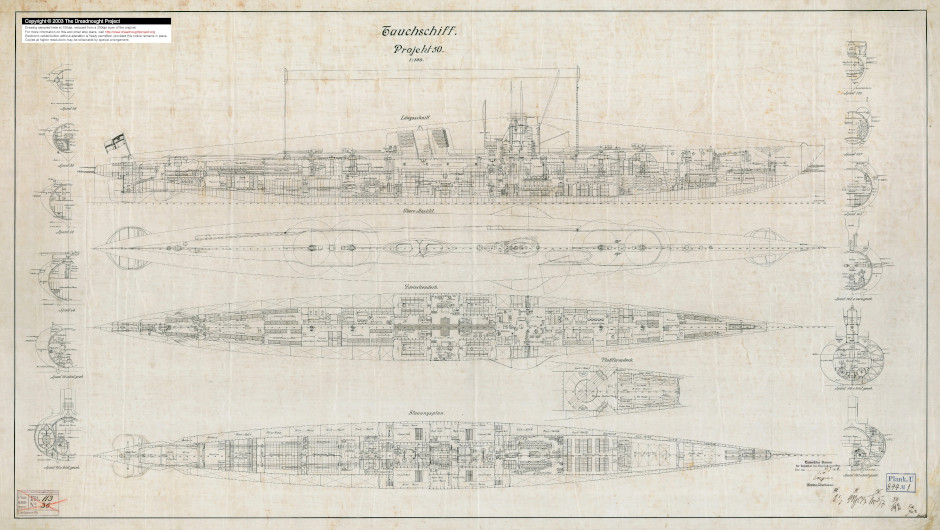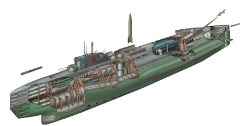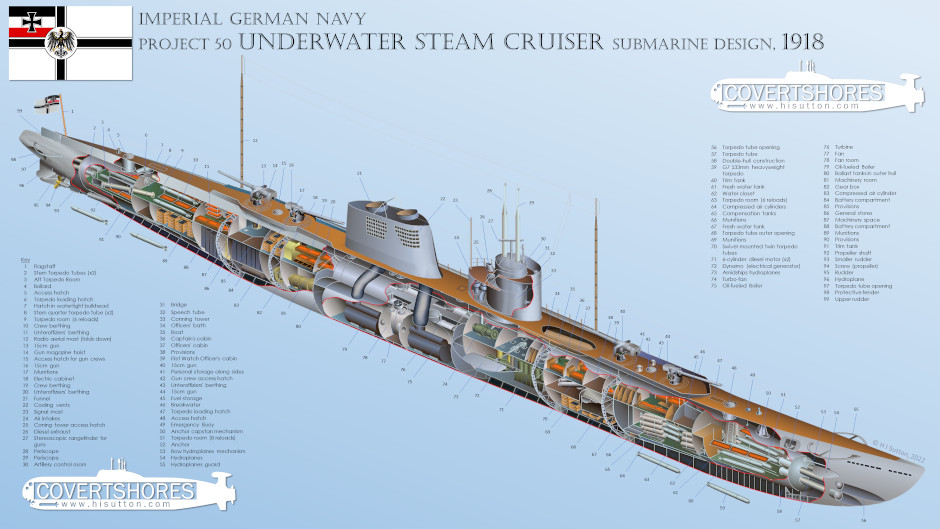The Kaiser's Forgotten Steam-Powered Super Submarine, Project 50
 During World War One Germany was undoubtedly one of the leading countries for submarines. Their mainstay types were extremely combat effective. But they were not known for extreme designs. In tis regard, the British generally built bigger and more elaborate designs. But Germany did build a few large submarines.
During World War One Germany was undoubtedly one of the leading countries for submarines. Their mainstay types were extremely combat effective. But they were not known for extreme designs. In tis regard, the British generally built bigger and more elaborate designs. But Germany did build a few large submarines.
The Imperial German Navy (Kaiserliche Marine) built a series of underwater cruisers. Unlike their British counterparts, the K-Class, they were intended to operate as commerce raiders, rather than as part of a mixed fleet with battleships. In this sense they were more influential on interwar cruiser submarines like the French Surcouf than the more famous K-Class.
The most impressive design was the steam-powered Project 50 Tauchschiff (aka UD-1). This would have been the largest submarine in the world at the time. One was under construction at the end of the war (fact disputed) but was not finished in time. That boat was scrapped and this incredible design was largely forgotten. Here is more about it.
Project 50 was to be larger and more powerfully armed than the preceding types. German cruiser submarines can be summarized as:
- Project 46 (Type-139). Impressive 2,400 ton boats with diesel engines. 17,000 nautical mile range. 3 built
- Type U-142. Single boat, similar to Type-139.
- Type-151 Class (Deutschland Class). 2,200 ton boats designed as civilian transports but converted to cruiser submarines. Limited torpedo fit (due to conversion) but two large uns. 7 built.

U-139 Class (Project 46)
The most obvious way in which Project 50 was to be different was the propulsion. Like the British K-Class it was to have steam turbines for surface transit. This promised a much higher speed, around 25 knots compared to 15 for the Project 46.

CLICK to enlarge. Originally from The Dreadnought Project.
Additionally they would be armed with more weapons. The gun fit was to be doubled from 2 to 4 x SK L/45 15cm guns. Although not as large as some other guns aboard submarines, this was a very competent weapon. It could hit targets at about 15 km range, although likely shorter in the case of a submarine due to aiming challenges.
Get The essential guide to World Submarines
This Covert Shores Recognition Guide Covers over 80 classes of submarines including all types currently in service with World Navies.Check it out on Amazon
The torpedo armament was also increased from 6 to 10 x 533mm heavyweight tubes. Four tubes were mounted in the bow (with 8 reloads) and two in the stern. This much was typical of large submarines of the time. But then two more were added in the stern shooting out at an angle. These had their own torpedo room with up to 6 reloads. And two more 533mm tubes were added amidships in a rare (I think unique) swivel mount.
The swivel mount could be swung about 30 degrees left or right to align with firing ports on either side of the boat. It would be centered forward again for reloading. The reloads were carried in a torpedo room ahead of it so would be muzzle loaded. 6 reloads could be carried.
Total load-out, with all torpedo tubes full and all reload slots shown on plans, was to be 28 weapons.
Specifications (Provisional, based on mixed sources)
Displacement: 4,100 metrics tons submerged
Length: 125m
Beam: 10.8m
Operating depth: Tbc, relatively shallow
Speed: 25 knots surfaced, 5.2 knots submerged
Range: 13,200nm @ 10 kn surfaced, 80nm @ 4kn submerged
Propulsion: 4 x 6000 HP steam turbines, 2 x 450 HP diesel generators, 2 electric motors.
Armament: 4 x SK L/45 15cm (150mm) deck guns, 10 torpedo tubes (28 torpedoes)
Crew: 127
With hindsight steam power is generally considered a bad idea for submarines. It is potentially very dangerous if flooding occurs, and takes a long time to prepare for diving. It can also makes the submarine very hot. Project 50 appears to have tried to minimize these risks by placing the four oil-fueled boilers in separate compartments. These were mounted outboard of the main hull, essentially in the outer hull. Two fan rooms were built in for cooling. There was also a turbo-fan.
The ultimate book of Special Forces subs Covert Shores 2nd Edition is the ONLY world history of naval Special Forces, their missions and their specialist vehicles. SEALs, SBS, COMSUBIN, Sh-13, Spetsnaz, Kampfschwimmers, Commando Hubert, 4RR and many more.
Check it out on Amazon
Like other steam submarines it had a bank of batteries for submerged power. Curiously however, it seems that these would be recharged by two large diesel generators instead of the steam turbine. So in essence, it ad tree powerplants.
Accommodation appears to have been quite good for a submarine, with the three most senior officers each having a singe cabin. There was also a bath for the officers, medical facilities and 5 toilets.
We can only speculate how effective the Project-50 would have been. It would have been impressive for sure, the largest in the world. Surcouf would have competition.
Related articles (Full index of popular Covert Shores articles)

 World war One Type UC-1 U-boat w/Cutaway
World war One Type UC-1 U-boat w/Cutaway





 Nordenfelt steam powered submarines of the 1880s. w/Cutaway
Nordenfelt steam powered submarines of the 1880s. w/Cutaway

 Surcouf Cruiser Submarine w/Cutaway
Surcouf Cruiser Submarine w/Cutaway

 Type-XXIXH stealth U-Boat. w/Cutaway
Type-XXIXH stealth U-Boat. w/Cutaway

 Stalin's Super Sub, Project P-2. w/Cutaway
Stalin's Super Sub, Project P-2. w/Cutaway





